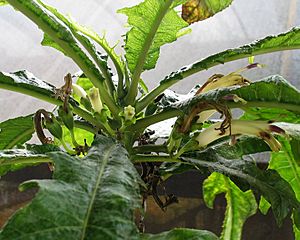Sharktail cyanea facts for kids
Quick facts for kids Sharktail cyanea |
|
|---|---|
 |
|
| Conservation status | |
| Scientific classification | |
| Genus: |
Cyanea
|
| Species: |
pinnatifida
|
The Cyanea pinnatifida is a very rare flowering plant. It belongs to the bellflower family. People often call it the sharktail cyanea. In the Hawaiian language, it is known as haha. This plant is special because it only grew naturally on the island of Oahu in Hawaii. Sadly, it is now extinct in the wild. This means it no longer grows on its own in nature. You can only find it growing in special gardens or plant collections.
Contents
About the Sharktail Cyanea
The sharktail cyanea is a unique plant from Hawaii. It is part of a group of plants called Hawaiian lobelioids. These plants are found only in Hawaii.
What it Looks Like
This plant is a shrub, which is like a small bush. It can grow up to ten feet tall. Its leaves are interesting because they are deeply divided into a few parts. The plant also produces flowers. These flowers grow in a cluster called an inflorescence. There can be up to 15 flowers in one cluster. They are white with a hint of green and have purple stripes.
Where it Lives and Its History
The sharktail cyanea used to live in the Waianae Mountains on Oahu. In 1991, scientists realized how rare it was. At that time, there was only one plant left in the wild. This last plant died in 2001.
Today, some of these plants are kept safe at the Lyon Arboretum in Honolulu. This is like a special garden where rare plants are cared for. A few young plants have also been put back into suitable areas in nature. However, these young plants have not grown or reproduced on their own yet. Because of this, the plant is still considered extinct in the wild.
Why it Became So Rare
The main reason the sharktail cyanea almost disappeared was because its home was destroyed. Many things caused this damage.
Threats to the Plant
- Wild Pigs: One of the biggest problems was wild pigs. These pigs would dig up the ground and eat plants. This damaged the places where the cyanea grew.
- New Plants: Other plants that were brought to Hawaii from different places also caused trouble. These "introduced plants" grew very fast. They took over the space and sunlight that the native cyanea needed. Examples include a plant called Koster's curse and a type of passionflower.
- Pests: Small animals like rats and slugs also caused harm. They are known to damage many types of Cyanea plants, including the sharktail cyanea.
Scientists know very little about how this plant lives and grows. This is because so few of them have ever been seen or studied. Protecting the remaining plants is very important for their future.


